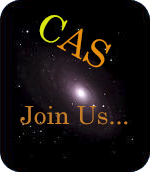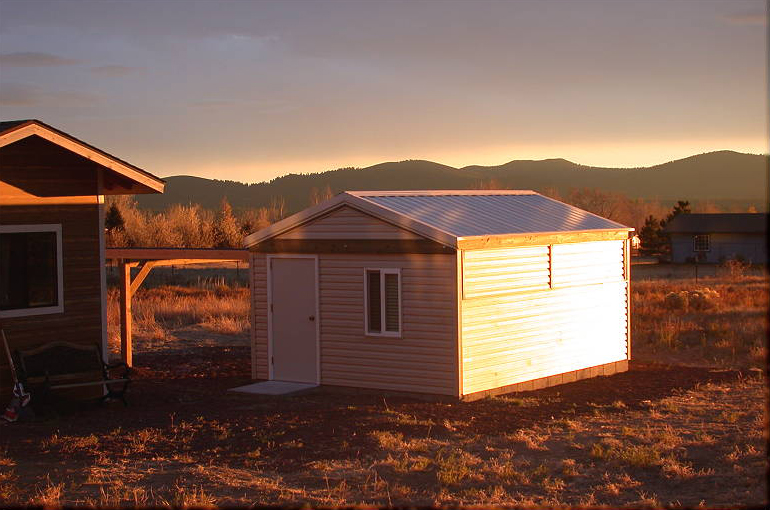Klaus
Yes
CAS ex vice president Klaus Brasch and his wife Margaret retired to Flagstaff in 2006, after rewarding careers in biomedical research, teaching and administration at several universities in the US and Canada. Though a biologist professionally, Klaus got hooked on astronomy in his teens through the Royal Astronomical Society of Canada and the Association of Lunar and Planetary Observers, and has maintained an active interest ever since.
In the 1970s at Queen’s University in Ontario, Klaus teamed with radio astronomer Alan Bridle to develop a then-pioneering course on “Planets and Life” and later taught “Life in the Cosmos” at California State University, San Bernardino.
An avid astro-photographer, Klaus took his first grainy moon pictures in 1959 and now enjoys digital imaging from his backyard observatory in Flagstaff. His images and articles have widely been published in popular books and magazines, including Sky & Telescope, Sky News, Astronomy Technology Today, the Journal of the British Astronomical Association and the Journal of the Royal Astronomical Society of Canada.
Klaus and Margaret have translated several French books into English, including Urban Astronomy, Great Observatories of the World, New Atlas of the Moon and Space Probes, for Oxford University Press and Firefly Books. Klaus also lectures on topics ranging from astro-imaging to life in the universe, at star parties, astronomy clubs and the public program at Lowell Observatory.
The following articles are published here with permission of the Royal Astronomical Society of Canada.
A Brief History of Lunar Exploration: Part I
( December / décembre 2015 JRASC | Promoting Astronomy in Canada )
and
A Brief History of Lunar Exploration: Part II
( April / Avril 2016 JRASC | Promoting Astronomy in Canada )
by Klaus Brasch
Other Recent Articles
- W. Sheehan, K. Brasch, D. Cruikshank & R. Baum: The Ashen Light of Venus: the oldest unsolved solar system mystery, J. Br. Astron. Assoc. 124, 4, 209, 2014
- K. Brasch: Great Observatories, J. RASC, 108, 104, 2014
- K. Brasch: The Origin of Stacking. Sky & Telescope, 137, 68, 2014
- K. Brasch, T. Vitron & S. Levine: Lowell Observatory and its New Discovery Channel Telescope, J. RASC, 107, 105, 2013
- W. Sheehan & K. Brasch: The “Loch Ness” of Venus, Sky News, 19, 36, 2013
- K. Brasch: Fifty Years of Astrophotography, J. RASC, 106, 165, 2012
- K. Brasch: The CT-152 f/5.9 Achromatic Refractor, Astronomy Technology Today, 6, 5, 39, 2012
- K. Brasch: Chilean Imaging Odyssey. Sky & Telescope, 122, 72, 2011
In the spring of 2009, my long-time friend Terence Dickinson and I participated in an astro-expedition to the Atacama Desert of northern Chile. We spent 13 glorious days and nights at the Atacama Ranch www.spaceobs.com/ near the charming town of San Pedro de Atacama. Spaceobs.com caters to amateur astronomers and tourists from all over the world. This is the driest and most cloud- free region on the planet and features the darkest skies anywhere. The region is also home to some superb natural parks, lagoons and archaeological sites, and not too far from impressive European Southern Observatory (ESO).
In addition to enjoying the splendid southern hemisphere skies, we also took several hundred digital images of the Milky Way, the Magellanic Clouds, and the magnificent Carina Nebula, Omega Centauri and 47 Tucanae, among many other objects. In addition to using our own Canon DSLR cameras and assorted lenses, we were able to rent time on a C-14 equipped with Hyper Star and a Takahashi FS-102 apochromatic refractor.
As a longtime volunteer and docent in the public program at Lowell Observatory in Flagstaff, I have enjoyed access to the venerable 24-inch Clark refractor now close to 120 years old. This superb instrument is ideally suited for visual work on solar system objects, as originally intended by the observatory’s founder Percival Lowell. Naturally I have taken many opportunities to also use it photographically. Since this classic telescope is a traditional achromatic refractor, it does exhibit some chromatic aberration which makes it largely unsuitable for direct color imaging, but ideal for lunar photography in black and white mode. Both Lunar images shown were taken under good to excellent seeing conditions with a Canon 50D DSLR. In each case the final image was generated by stacking anywhere from 10 to 15 exposures taken in rapid succession and then combining and processing in RegiStax.
_200x135a.jpg)
Klaus observing with the |
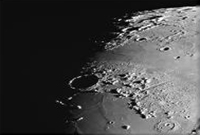
Plato region with the |
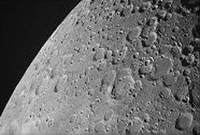
Maurolycus region |
Emission nebulae are among the most beautiful and colorful astronomical objects. These star-forming regions are scattered throughout our galactic neighborhood and since many are relatively near us, they are comparatively easy to image with moderate sized telescopes. These images were all taken from my backyard observatory over several years and with a variety of telescopes, including a TMB-92 mm f/5.5 apochromatic refractor, a TMB-130 mm f/7 refractor, a Celestron 14 SCT and a Celestron Edge HD C-11 at f/10 and f/7. All were shot with modified Canon DSLR cameras (50D and 6D) and an IDAS LPS-V3 filter to highlight the red hydrogen alpha, hydrogen beta and O3 emissions.
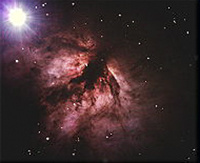
Flame Nebula |
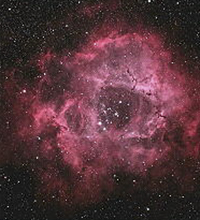
Rosette Nebula |
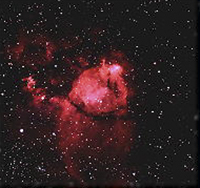
The Fishhead Nebula |
|
Northern Lights from Haukland Beach |
|
|
Northern Lights from Haukland Beach |
|
Galaxies
Galaxies are some of the most challenging and difficult objects to photograph. With the exception of M-31 the Andromeda galaxy and M-33 the Pinwheel galaxy, which are relatively close to us and hence bright and extended, most other galaxies appear small and faint in moderate size telescopes.
Except for M-31 taken with a TMB-92 mm apochromatic refractor, all others where imaged with a Celestron Edge HD C-11 at f/10 and f/6 and modified Canon 50D and 6D DSLR cameras. All images were generated by stacking 3-6 exposures and processing in Photoshop CS6.
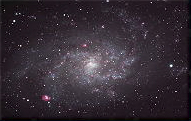
Triangulum Galaxy
M33 |
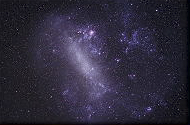
LMC ( Large Magellanic Cloud) |
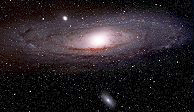
Andromeda Galaxy |
Imaging our Milky Way galaxy in piggy-back fashion using wide angle to medium telephoto lenses is the best way to get started in astrophotography. It’s both relatively easy and rewarding. Under really dark skies or with appropriate light pollution filters, one can capture beautiful Milky Way vistas with relatively short exposures. Moreover, if they overlap, such images can be combined into beautiful mosaics.
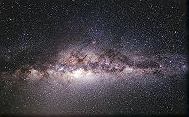
Milky Way |
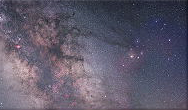
Antares region |
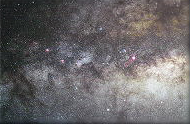
Milky Way |
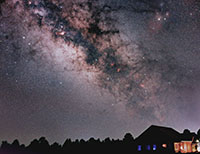
Milky Way from backyard |
Planetary Nebulae and super-nova remnants
These are among the most interesting astronomical objects since they represent the last vestiges of a star’s life. Sun-like and other smaller stars shed much of their mass at the end of their lives after they become red giants. The ejected material then expands into space resulting in a so-called “planetary” nebula (because early astronomers thought they look like planets). They are often very colorful and assume unusual shapes and sizes.
Supernovas result it two known ways. When very large stars run out of hydrogen and helium ‘fuel’, their cores collapse rapidly which triggers a massive explosion that often outshines the home galaxy in brightness for a period of time. Another way to produce a supernova is when a white dwarf reignites nuclear fusion by drawing matter from a nearby companion. This eventually leads to runaway nuclear fusion and a supernova explosion. In both types of supernovas, the bulk of the star’s mass is expelled into space, forming huge expanses of increasingly tenuous material that eventually dissipates into the interstellar medium.
The objects shown were imaged with various telescopes and modified Canon DSLR cameras.
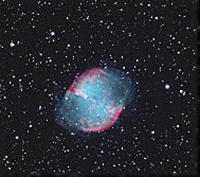
Dumbbell Nebula |
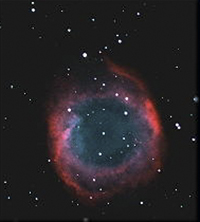
Helix Nebula |
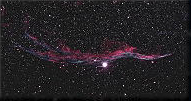
Veil Nebula West |
Solar System
Our solar system encompasses a huge range of objects, ranging from the sun itself, to planets, moons, asteroids and comets. I have included some interesting examples, including Comet Hartley near the Double Cluster in October 2009, the thin crescent of Venus imaged with the 24-inch Clark refractor at Lowell Observatory shortly before the 2012 transit, an image of Venus transiting the disk of the sun on May 29, 2012, and Comet Neowise July 14, 2020.
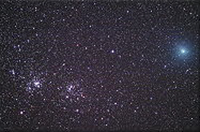
Comet Hartley |
Additional information is available from Wikipedia, the free encyclopedia, at http://en.wikipedia.org/wiki/103P/Hartley_2 |
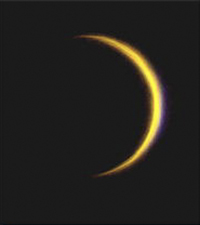
Venus May 29, 2012 |
Additional information is available from Wikipedia, the free encyclopedia, at http://en.wikipedia.org/wiki/Venus |
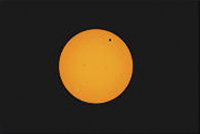
Transit of Venus |
Additional information is available from Wikipedia, the free encyclopedia, at http://en.wikipedia.org/wiki/Transit_of_Venus,_2012 |
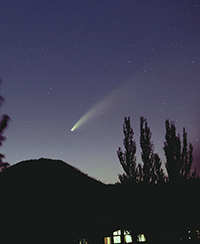
Comet Neowise |
I caught this image of Comet NEOWISE on July 14, 2020 from my backyard as it is visible low in the North West around 8:30 pm some distance below the Big Dipper. This image was shot with a modified Canon 6D and 135 mm lens, 10 seconds at ISO 1600 unguided. A beautiful sight in binoculars as well. Catch it while you can. |
Star Clusters
There are two main types of star clusters, globular and open. Globulars typically contain tens to hundreds of thousands of stars held together gravitationally into a globular roughly spherical mass. The stars in these objects are generally very old, often in the billions of years, and circle galaxies in large elliptical orbits. Open clusters, in contrast, have no defined shapes, consist primarily of relatively young stars that formed together within star-forming nebulae. Over time, these stars will drift apart within our galaxy.
I have included two of the best known star clusters of each type visible in the northern hemisphere, M-13 in the constellation of Hercules, M-45, the Pleiades in Taurus. M-13 is a favorite object for small telescopes and M-45 is an easy naked eye object and dazzling in any size telescope.
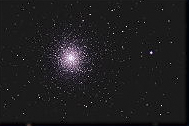
Great Globular Cluster in Hercules |
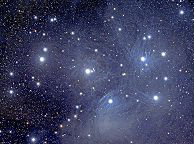
The Pleiades |
Outreach || Flagstaff || Photos || Articles || Observing Sites || Weather
Coordinated Universal Time || National Weather Service
info@coconinoastro.org

